|
|
 |
|
|
Early War German Vehicles Colours
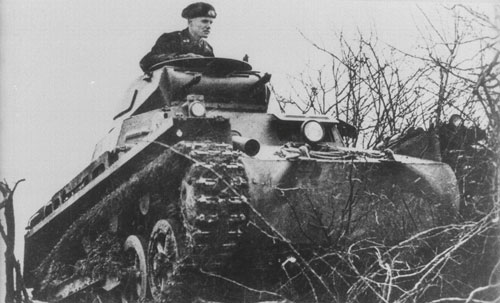 |
Early War German Vehicles Colours
by Dr. Michael L. McSwiney, Ph.D.
Contrary to popular belief, German vehicles from the outbreak of World War II provide the modeler and wargamer with numerous options for painting and marking. The Wehrmacht marking system underwent several changes from the start of the war until the fall of France. |
| This guide will provide options on painting and detailing German
military vehicles throughout that time period, with particular focus on
the Polish and French campaigns. However, no guide can be
comprehensive, so it is always advisable to consult good photographic
references to verify the style and placement of markings appropriate to
any specific campaign or battle. |
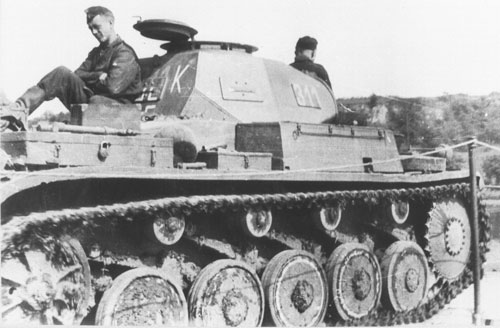 |
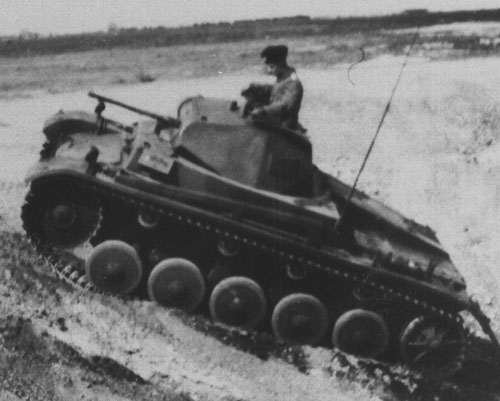 |
Camouflage
As recently as ten years ago the overwhelming consensus regarding early
war German AFV paint schemes was that they were all painted in uniform
overall panzer grey (Dunkelgrau - RAL 7021 – formerly RAL 46). However,
in 2002 Tom Jentz and Hilary Doyle published an article based on primary
sources stating all German vehicles at the beginning of World War II
were painted in a two tone camouflage scheme of panzer grey with one
third of the vehicle painted in a disruptive pattern of dark brown
(Dunkelbraun - RAL 7017 – formerly RAL 45). The order to move to an
overall panzer grey scheme was not signed until the end of July 1940. |
They therefore contend that all German vehicles should be painted in
this two-tone scheme through the end of the French campaign.
Unfortunately, as Jentz states, “There are very few quality photographs
where this two-tone camouflage scheme can be seen.” While Jentz and
Doyle have promised a comprehensive updated work detailing accurate
paint schemes, eight years have passed and the volume has not appeared.
Jentz and Doyle’s assertions have not been universally accepted as some recent references cite the same regulations as Jentz and Doyle but often interpret them differently. Chorý contends that while the two tone scheme was the official scheme according to OKH regulations, based on his interpretation of the photographic evidence many vehicles appear to be painted in an overall dark gray with no disruptive scheme applied as early as the Polish Campaign.
|
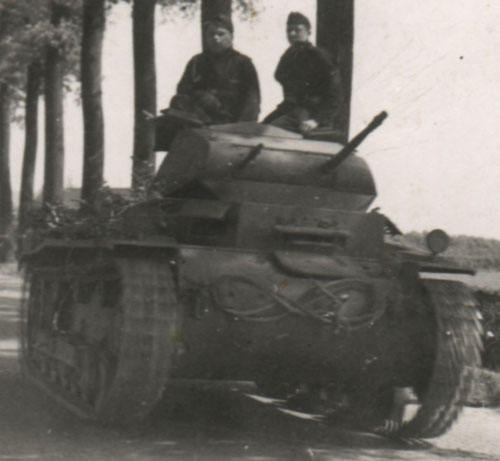 |
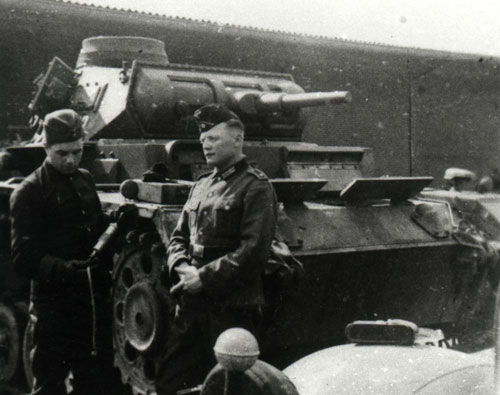
|
He and some other authors contend that the July 1940 overall panzer grey
order was issued to bring what was already being practiced in the field
in line with regulation. However, Chorý does allow that because the
dark grey and dark brown hues
were very close in contrast, they may appear indistinguishable in a
black and white photograph. Therefore a vehicle which appears to be
painted in uniform dark grey may actually be painted in two-tone
camouflage. The Panzerwaffe series of books includes a number of color
photographs which appear to show vehicles in a two-tone scheme during
the battle of France, but it is unclear whether these photos are extant
or have been colorised. The book’s color plates are based on drawings
by Doyle and therefore follow the two-tone scheme throughout the French
campaign. |
The modeler is therefore presented with some alternatives. Current best evidence strongly implies that German military vehicles were painted in a two-tone scheme through the end of the Battle of France. There are a few good photos out there (if you hunt for them), but most of the extant photos are Rorschach tests at this point. Because there is disagreement in the printed references, one could conceivably field an all panzer grey force or a mixed force of overall grey and two-toned vehicles. Another important consideration is the choice of paint color. There are many paints on the market that match the original Dunkelgrau (see table below), but fewer matches for the Dunkelbraun color. Another important consideration is that a correct two-tone scheme is going to be very low in contrast – especially on a 15mm miniature. Some may therefore choose a slightly lighter shade of brown for aesthetic reasons.
|
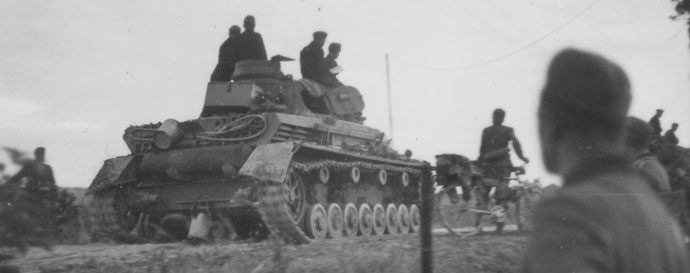 |
Panzer Dark Grey (Dunkelgrau RAL 7021)
|
Manufacturer
|
Paint Name / Code
|
FoW
|
Model Color Worn Rubber (FWP302) or Model Color Panzer Grey (FWP303)
|
Humbrol
|
67 Tank Grey or 182 Black Grey |
Tamiya
|
German Grey XF63 |
Gunze
|
TC-1
|
Lifecolor
|
UA207 – RAL 7021 Schwarzgrau / Panzergrau
|
Testors (Enamel)
|
Panzer Schwarzgrau 39/43 RAL7021
|
Testors (Acrylic)
|
Panzer Schwarzgrau Acryl
|
|
Panzer Dark Brown (Dunkelbraun RAL 7017)
|
| Manufacturer |
Paint Name / Code |
FoW
|
Model Color Grease Brown (FWP320) or Model Color Boot Brown (FWP323)
|
| Humbrol |
10
|
| Tamiya |
No direct match
|
| Gunze |
No direct match
|
Lifecolor
|
UA210 – RAL 7017 Dunkelbraun
|
Testors (Enamel)
|
No direct match
|
Testors (Acrylic)
|
No direct match
|
|
National Insignia
The original national insignia used on German tanks and other AFV’s was a plain white cross. The cross varied in size, but was generally applied to multiple sides of the vehicle (often three or four sides). Unfortunately the white cross on the dark grey/brown background was incredibly conspicuous and served as an aiming point for Polish anti-tank weapons and artillery. As an expedient, many crews simply covered the cross with mud. Another solution was to paint over the white cross with yellow (Gelb RAL 1006) – either leaving thin white lines around the cross or completely covering over the original white cross. While this improved the contrast problem to a large degree, some of these modified crosses were also covered in mud. One therefore has several options for modeling Polish campaign vehicles: white insignia, yellow insignia with a white outline, and yellow insignia. Any of these variants can also be covered with mud.
|
 |
OKH regulation H.M. 1939, Nr. 770 officially replaced the white cross with the more familiar open cross for the rest of the war. The regulation cross came in a few varieties – one is the common black cross with a white border and a thin black line just outside the white border. In 15mm scale the thin outside lines are often invisible. The regulation height of the crosses was 25cm, but photographic references show a variety in both size and thickness of the cross. Alternately the black center and outline were dropped creating a hollow cross using the open white border. In modeling any of the campaigns after the Polish campaign, the traditional black and white insignia or an open white cross should therefore be used.
|
| Before the Polish campaign, all tanks were
painted with crosses on all four sides of the vehicle. For the sides
and rear, the cross generally appeared on the turret. The front cross,
however, varied somewhat in placement with some tanks having it on the
turret front (such as the Panzer I) while others had it on the hull
front near the driver’s vision slit. After the Polish campaign, the
front cross was removed entirely. Left and right side national insignia
were generally moved to the hull of the tank from the turret. Small
crosses on the turret rear are evident on several vehicles (especially
the Panzer 38(t), Panzer III and Panzer IV as well as some Panzer II)
whereas others move the cross to the hull rear (Panzer I and some Panzer
II). |
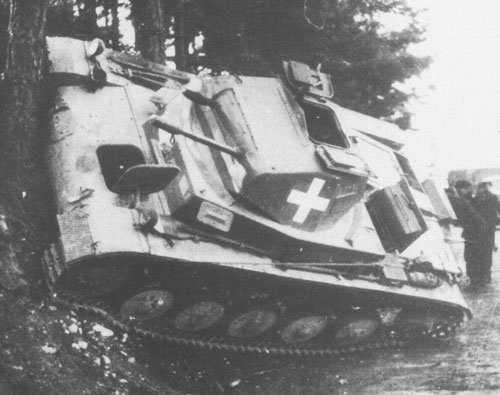 |
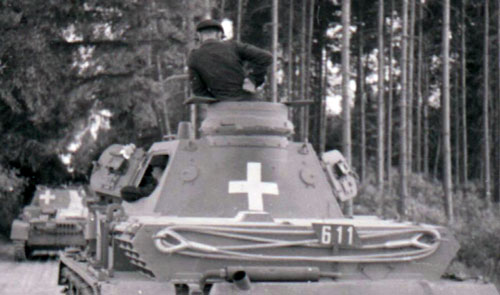 |
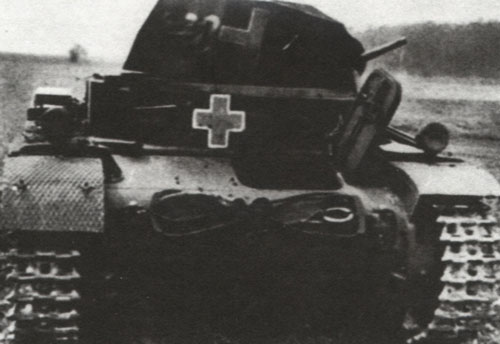 |
Tactical Numbers
Early tactical numbers were attached to vehicles on small rhombus shaped plates. The numbers were generally small and painted in white while the rhomboid plate itself was dark gray (RAL 7021) or occasionally black (RAL 9005). Unfortunately these small tactical numbers were frequently difficult to identify in combat, so many vehicles sported larger tactical numbers in white on the hull and/or turret. As with the bright white national insignia, these larger white tactical numbers were frequently painted over in yellow. Replicating these variants provides the modeler with several options for Polish campaign vehicles.
|
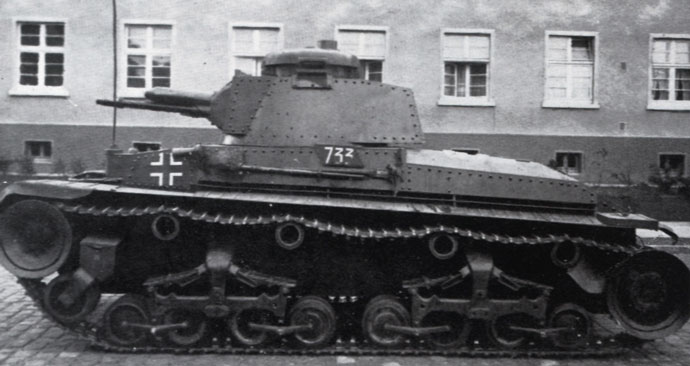 |
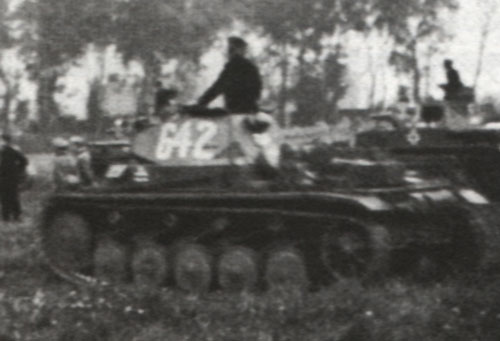 |
In the French campaign, there is a remarkable lack of standardization in the numbering style used on German vehicles. Part of the reason for this variety stems from the fact that the Wehrmacht was experimenting with a variety of styles in this period. It is therefore appropriate to model French campaign vehicles with white numbers, red numbers with a white outline, or simply numbers consisting of a white outline. Some of these numbers were stenciled, others were painted on freehand. In many cases the rhombus plates from the Polish campaign were carried over as well. One consistent feature of the tactical numbers used after the Polish campaign was the fact that they tended to be smaller.
|
Because of the variety of numbers used, it’s impossible to comprehensively detail what division used what type of number, but the table below is representative based on photographs in current references. Where possible I’ve also included the national insignia type. Unfortunately as the table below demonstrates, there was very little standardization of markings (either numerical or insignia) even within the same division. One excellent photo shows two Panzer IV’s from 7. Pz. Division parked next to each other – their turret numbers follow the same pattern, but the insignia are different (one is hollow, one is black with white outline).
|
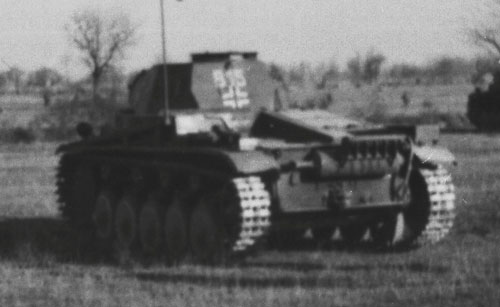
|
Number Type/Style
|
Insignia Style
|
Division
|
Vehicle Type
|
Marking Locations/Other markings
|
Red-white outline
|
Black
|
7. Pz. Div.
|
Panzer IV
|
Number: Turret sides / rear
|
Small yellow
|
Hollow
|
10. Pz. Div.
|
Panzer III
|
Number & Insignia: Hull sides/rear 2. Co added yellow roman number II to turret sides/rear
|
Small white on black rhomboid
|
Hollow
|
5. Pz. Div.
|
Panzer IV
|
Number & Insignia: Hull sides / rear(?)
|
Yellow
|
Hollow or Black
|
7. Pz. Div.
|
Panzer IV
|
Number: Turret sides (rear?) Insignia: Turret sides (rear?) Note – some 7. Pz. Div. were unusual in having a large first digit.
|
Small yellow
|
Black
|
Unknown
|
Panzer III
|
Number: Turret sides / rear Insignia: Hull sides and turret rear
|
White
|
Hollow
|
Unknown
|
Panzer IV
|
Number: Turret sides (rear?) Insignia: Hull sides (rear?)
|
Small yellow
|
Hollow
|
9. Pz. Div.
|
Panzer IV
|
Number: Turret sides (rear?) Insignia: Hull sides (rear?)
|
Small white on black rhomboid
|
Black
|
2. Pz. Div.
|
Panzer II
|
Number & Insignia: Hull sides / rear(?)
|
Small white
|
None
|
1. Pz. Div.
|
Panzer III
|
Number: Turret sides (rear?)
|
Small white on gray rhomboid
|
Black
|
5. Pz. Div.
|
Panzer IV
|
Number & Insignia: Hull sides / rear(?) – also carries the red devil head marking of PzRegt 31 on the turret sides.
|
|
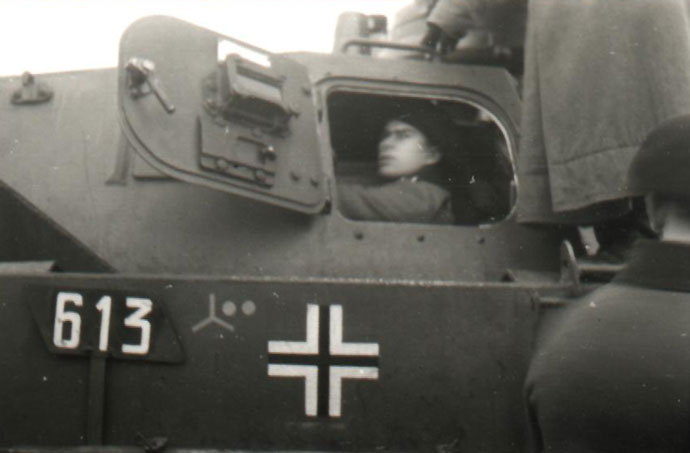 |
Panzer Division Symbols and Other Markings
Many tanks and other AFV’s carried either panzer division symbols or
tactical symbols. The number and placement of these varied widely from
unit to unit – even within the same division. Several units added names
or other personal heraldry to their vehicles as well. While a few of
these markings are mentioned in the table above, it is best to consult
good photographic references for placement of these additional markings
(if desired).
Below are lists of the Panzer Divisions used in the Polish Campaign and the Lowlands / France Campaign:
|
Polish Campaign
|
French Campaign
|
1st Panzer Division
|
1st Panzer Division |
2nd Panzer Division
|
2nd Panzer Division |
3rd Panzer Divison
|
3rd Panzer Divison |
4th Panzer Division
|
4th Panzer Division |
5th Panzer Divison
|
5th Panzer Divison |
10th Panzer Division
|
6th Panzer Divison* |
Panzer Division Kempf
|
7th Panzer Divison** |
1st Leichte Division
|
8th Panzer Divison** |
2nd Leichte Division
|
9th Panzer Divison |
3rd Leichte Division
|
10th Panzer Divison |
|
* = The 6th Panzer Division was the only division equipped with the Panzer 35(t).
** = The Panzer 38(t) was fielded by the 7th and 8th Panzer Divisions.
|
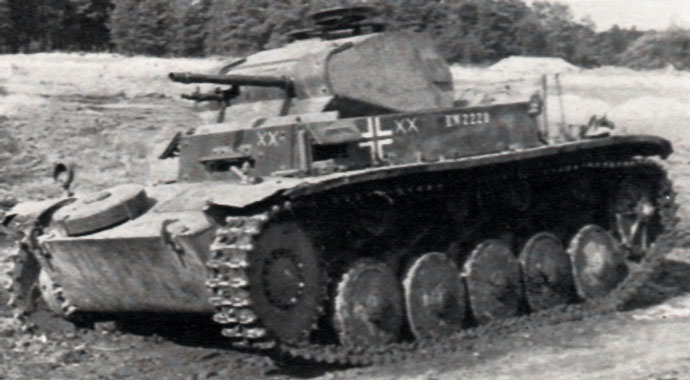 |
References
Chory, T. (2005). Camouflage Colors, Wehrmacht Heer, 1939-1945. (C. K. Kliment, Trans.) Namest na Hane, Czech Republic: Aura Design Studio.
Healy, M. (2007). Panzerwaffe Volume Two: The Campaigns in the West 1940. Hersham, Surrey, United Kingdom: Ian Allan.
Jentz, T. L., & Doyle, H. L. (2002). Facts About German Camouflage Paint in World War II. Retrieved May 25, 2010, from missing-lynx.com: http://www.missing-lynx.com/panzer_facts.htm
Jentz, T. L., & Doyle, H. L. (2002). Panzer Tracts No.1-2 Panzerkampfagen I Kl.Pz.Bef.Wg. to VK 18.01. Boyds, Maryland: Panzer Tracts.
Military Miniatures Magazine. (2008, May 8). RAL Colour Conversion Table. Retrieved May 25, 2010, from Military Miniatures Magazine: http://www.miniatures.de/colour-ral-farben.html
Parada, G. (2010). Panzer Colors 1934-1945. Retrieved May 25, 2010, from Achtung Panzer: http://www.achtungpanzer.com/panzer-colors-1934-1945.htm
Strasheim, R., Prigent, J., Jurado, C. C., Franco, L. M., & Russ, W. (2007). Panzerwaffe Volume One: The Eveolution of the Panzerwaffe to the Fall of Poland 1939. (J. Prigent, Ed.) Hersham, Surrey, United Kingdom: Ian Allan Publishing Limited.
|
Want To Know More About Blitzkrieg?
Over the past few months we have added a massive range of articles
about Blitzkrieg to the website, to make it easier for people to find a
specific article we have put together this handy place.
Find out more about Blitzkrieg and Early-war here...
|
Last Updated On Wednesday, July 8, 2015
|
|
|